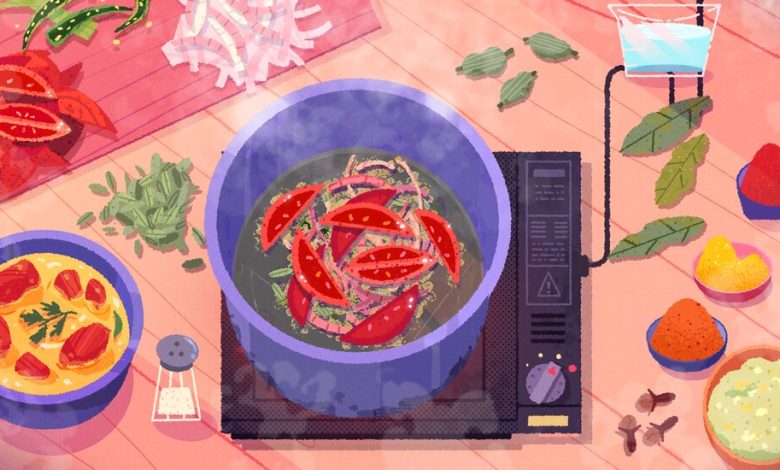Sizzling Dishes and Stressful Meals Give Video Games Warmth

Food in video games is often referred to as a “consumable,” a resource that confers health or another perk on the player. But in Venba, a narrative cooking game, food is something more: It’s something to labor over, to infuse with rich emotions, to savor.
In one scene, an immigrant mother cooks a meal for her son, expecting him home from university. Chicken drumsticks simmer in a sticky sauce; a whole fish sizzles in a frying pan; an unctuous golden curry bubbles. But the son does not show up, and as the afternoon light fades, the bountiful platter of delicately spiced food goes cold.
This was the first idea the designer Abhi Swaminathan had for Venba, which traces the challenges of an Indian family that has immigrated to Canada in the 1980s. The concept germinated while he was at his mother’s home in Toronto as she was “fussing over dinner.” He recalled immediately sending a text to the game’s lead artist, Sam Elkana, who was coincidentally breaking bread at a nearby restaurant with his own “amma” (a word for mother in India).
Despite Venba’s three-year development phase, this scene of prepared-yet-uneaten food made it into the final game essentially untouched. It contains almost the entire thematic thrust of the indie title: Cooking is fundamentally an act of care, and generational and geographic distance can produce unsettling melancholy.
“For South Asian women who have been put in the role of the family caregiver, cooking is a very big deal,” Swaminathan said. “If you say no to a meal, or you don’t show up for a meal, it affects them very strongly. For me, the thought was, Why is that?”
By foregrounding food in a touching diasporic story, Venba, released in July, sits apart from arcade takes on cooking like the Cooking Mama and Cook, Serve, Delicious! franchises. It does not grade your dishes, or ask the player to complete a culinary task by repeatedly tapping buttons.
Venba is interested instead in food’s emotional resonance, putting it in conversation with video games like Thirsty Suitors, Tet and the forthcoming Consume Me and Nainai’s Recipe, as well as recent books like Michelle Zauner’s memoir, “Crying in H Mart,” and Bryan Washington’s novel “Family Meal.”
The first project from Visai Games, a Toronto-based studio, Venba features light puzzles that require the player to piece together recipes in the correct order, using the faded and food-splattered directions written down by the protagonist’s own mother. Importantly, there are no repercussions for failing — you simply start over, as the caring cook would.
“Making a bad meal is canonically impossible in the story,” said Swaminathan, who added that he hopes to impart genuine cooking knowledge to enthusiastic players. “Even something as simple as putting onions and aromatics in before the tomatoes — there’s a reason for that. It’s about getting players to think about the steps instead of blindly following directions.”
Venba’s vivid re-creation of Tamil cuisine, which includes a hearty rasam soup and savory crepes called dosas that are made from a fermented batter, is powerful. Swaminathan cooked each of the game’s recipes himself, painstakingly documenting each step with photographs that were then reimagined by Elkana in a lightly animated, hand-drawn visual style. The game’s sound designer, Neha Patel, was similarly exacting, capturing each popping mustard seed and sautéing onion with a suite of microphones arranged around her cooker.
Like so many other virtual takes on real-world pursuits, cooking in video games is both an abstraction and an impression.
The gastronomic scenes in the narrative-adventure game Thirsty Suitors, released this month, are as much about people — particularly the protagonist, Jala, and her judgmental mother — as they are about the food. “Editing down to the emotional beats of the relationship was the important thing for us,” said Chandana Ekanayake, the game’s creative director.
While the player is busied with the essentials of making an Indian flatbread called paratha — twirling an analog stick to mimic the mixing of oil, flour and water; rapidly pressing a button as if shaking a frying pan — dialogue between Jala and her mother plays out.
“For lots of us, doing something with your hands, or doing a joint activity with your parents is a way to open up a conversation you might not want to have otherwise,” said the narrative lead, Meghna Jayanth, who drew on mealtime experiences with her South Asian family.
Help Jala nail a recipe and she’ll inspire a “Ratatouille”-esque flashback in her parents, catapulting them through space and time to their previous life in India. But even after such a transcendent experience, Jala’s mother retains her cool, emotionally distant demeanor: “It tastes … decent,” she says of her daughter’s nearly immaculate paratha.
Family, celebration and belonging are the central ingredients of Venba and Thirsty Suitors, but anxiety and compulsion lurk in the darker Consume Me, an upcoming game from Jenny Jiao Hsia and AP Thomson. Taking inspiration from Lucas Pope’s bureaucratic puzzle simulator Papers, Please, it uses the numeric, computational foundations of video games to explore Hsia’s own experience of dieting in high school.
“I was obsessed with the numbers on the scale, the calorie counts,” she said.
Assuming the role of Jenny herself, the player completes a series of WarioWare-style mini-games centering on activities like yoga, makeup application and what its creators call “food Tetris.” If one of the needs meters you must manage — energy, mood or guts, which applies to both your stomach’s health and how brave you’re feeling — falls to zero, Jenny experiences nightmarish visions and the game ends.
Hsia, who said in an interview that she “engaged in disordered eating” as a teenager, worries that the game’s brightly colored take on intense subject matter might be misinterpreted as a guide for people seeking to control their weight. But it was an intentional choice for the events to unfold without an overtly didactic message.
“The game doesn’t present solutions to these problems,” Thomson said. “We’re showing you how this went down for Jenny in her own life, and it doesn’t necessarily resolve in a way that’s clean or satisfying.”
Telling authentic cultural stories is gaining importance in video games, which Ekanayake explicitly addressed while courting publishers and investors for Thirsty Suitors. His current television obsession, K-drama, has exploded in popularity in recent years.
“Part of our pitch was the idea of how broader media and culture is starting to show, not just South Asian stories, but stories from other cultures through the globalization of platforms like Netflix and Amazon,” said Ekanayake, who hopes that games that treat food seriously will not merely be a flash in the pan.
On the day Venba was released, Swaminathan was delighted to see a cohort of Tamil YouTubers playing the game, including one whose amma sat alongside him to helped him complete the puzzles. “Every reference, every detail that I put in there, they caught all of it,” he said.
Games like these are among the most visible ways that creators are pushing beyond the action-hero power fantasies starring white male protagonists. Jayanth, the narrative lead for Thirsty Suitors, stressed that food in video games can be both an affirmation for those familiar with its sights, smells and sounds, and an invitation to those who are not.
“Immigrant food is the lifeblood of cuisine” in the United Kingdom, said Jayanth, who also spends time in India. “It’s an easy way to get people to come into your culture. But, you know, if you’re going to eat our food, get to know us, too. We’re just as big and vibrant.”





